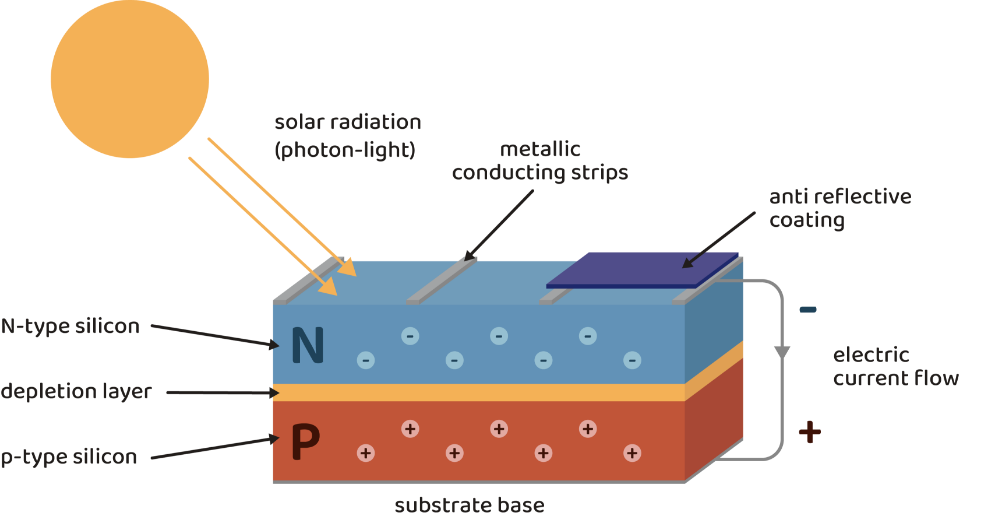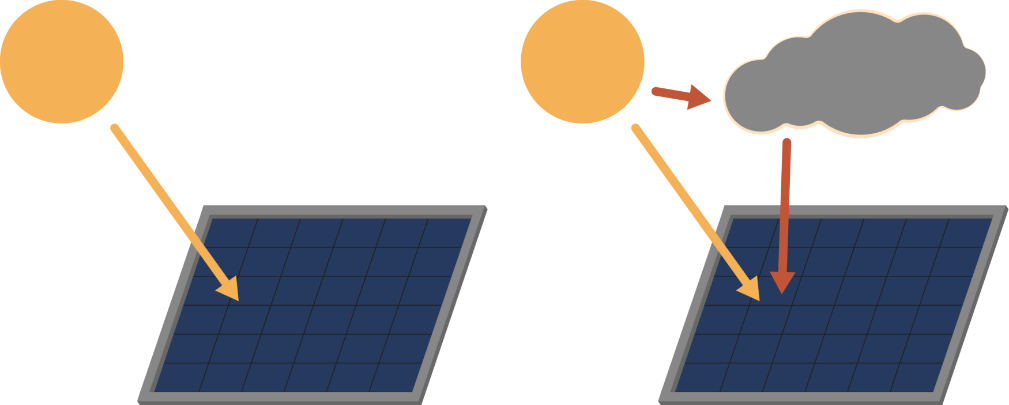Have you ever wondered whether solar panels lose their effectiveness when the winter chill sets in or on cloudy, overcast days? What happens on the winter days when there is only sunlight for (on average) 7 hours and 49 minutes in the UK? (Source, 2024)
In the UK, cloudy days are a regular occurrence, so it is only understandable why people ask the question,“Do solar panels work on cloudy days and in the winter?”. Many people believe that solar panels thrive only under the brilliant sun of summer days.
However, this is where we come in to debunk some common myths. Rest assured that this is merely a widespread myth that solar panels are less effective during the winter and on cloudy days. Solar energy is still a dependable and resilient source of renewable energy. They can benefit from the sun’s natural energy in every month of the year – even on cloudy and short winter days.
We aim to shed light on how solar panels continue to perform, not just when bathed in sunlight, but also during the colder, cloudier days of the year. We’ll explore the intriguing ways in which solar panels harness light to generate energy, regardless of the season. Additionally, we’ll delve into the pivotal role of solar battery storage in ensuring a steady supply of energy, whatever the weather may bring.
do solar panels hibernate in winter? unveiling their performance on cloudy days.
What’s on this page?
How do solar panels work?
Firstly, we need to understand how solar panels operate and what makes them produce energy.
At first glance, solar panels might seem like sheets of dark glass sitting atop roofs, quietly basking in the sunlight. But at the heart of every solar panel are photovoltaic (PV) cells, which essentially generate power from daylight, not sunlight or heat.
PV cells are made using semi-conducting substances, often silicon. When the light shines on the silicone, the cells get excited. This excitement isn’t just for show; it’s the silicon electrons getting all hyped up and moving around, which creates an electrical current. It’s this current that is harnessed and converted into the electricity that powers everything from your kettle to your TV.

How do solar panels work on cloudy days and in the winter?
Solar panels don’t need the sun to be shining brightly to work their magic. They need light.
Yes, even on those grey, overcast days, there is still enough light filtering through the clouds to get those silicon electrons grooving.
And in the chill of winter?
The cold can actually make solar panels work more efficiently. Think of it like this: on a crisp, cold day, you might perform better on your morning run compared to a sweltering hot day. Similarly, the cooler temperatures can help improve the performance of the solar panels, making them more efficient at converting sunlight into electricity.
So, while solar panels love basking in direct sunlight, they’re not sunbathers at heart. They’re hard at work, come rain or shine, converting whatever light they can get into clean, green energy. It’s a reminder that even on the days when the sun seems to be playing hide and seek, your solar panels are still on the job, doing their bit for your home and the planet.
Of course, winter brings its own set of challenges, like the occasional blanket of snow covering the panels. But, just as you might sweep your walkway, a quick brush-off of the panels can get them back to their energy-producing glory. And let’s not forget the angle of installation; many solar systems are set up with winter in mind, tilted to catch the sun’s lower trajectory across the sky.
The myths of inactivity: The Cloud Edge Effect
Solar panels can work with diffused light. Although the amount of sunlight is reduced, it doesn’t disappear completely on cloudy days.
The light that filters through is still captured by solar panels, which continue to generate electricity.
Solar panels are more like tortoises than hares on cloudy days. The energy production won’t break any records, but it’s steady, proving the point that every little helps. In fact, some types of solar panels, particularly those designed to capture a broader spectrum of light, can be adept at working in lower light conditions, making them effective even when the sun has taken a day off.
There is also the phenomenon known as the cloud edge effect.
This occurs when solar irradiance is actually higher right as a cloud passes over a solar array. In other words, this happens when the sun peeks around the edges of clouds, leading to a temporary boost in light intensity. Solar panels love this and can produce even more power than on a cloudless day, although briefly. The sunlight is magnified, resulting in a significantly higher electrical output which, just like humans when they’re running and suddenly get a burst of energy, the cloud edge effect can give solar cells that little extra boost.

So, regardless of whether it is winter, cloudy, or a rainy day, solar panels are up there, quietly and efficiently converting whatever light they can get into energy. It’s a reminder that, in the world of solar energy, every day is a good day; some are just a bit more productive than others.
Maximising solar panel winter performance
You might be wondering, “How can I ensure my solar setup is putting its best foot forward during the winter months?”.
Fear not, for we have a few tricks up our sleeve to keep your panels performing at their peak, even when the weather outside is more suited for a cup of hot cocoa by the fire.
Let there be light (on your panels)
First things first, let’s talk about keeping those panels clear. Snow might look pretty, but it’s not exactly a friend to solar production. A simple sweep with a soft brush or a solar panel snow rake can work wonders. Remember, even a thin layer of snow can significantly reduce your panels’ effectiveness, so keep them as clear as you can.
Angle for Success
As the sun decides to take a lower arc across the sky in winter, the angle of your solar panels becomes even more crucial. If adjustable, tilting your panels to capture more of that precious winter sunlight can make a noticeable difference. The ideal angle varies depending on your location, but aiming for a steeper tilt helps catch the sun’s lower trajectory.
Embrace regular check-ups
Winter is a great time to give your solar system a health check. Ensuring cables are intact, connections are tight, and the system as a whole is in good working order can prevent unexpected hitches in performance. Consider it a bit like a winter coat for your system – making sure it’s ready to face the elements.
Mind the shadows
With the sun hanging low, shadows can become more of a performance pest than in the summer months. Keep an eye on trees, buildings, or other structures that might cast longer shadows over your panels. A bit of strategic trimming or planning can help minimise these shadowy intruders.
Consult the experts
If you need help deciding how to optimise your solar panels for winter, reaching out to a professional can be a good idea. They can offer personalised advice tailored to your specific setup and location, ensuring you’re squeezing every bit of energy out of those shorter days.
By following these tips, you can help ensure that your solar panels aren’t just surviving the winter but thriving through it. So, while the weather outside may be frightful, the efficiency of your solar panels can still be quite delightful.
Solar Battery Storage: The Solution
Most homes use more energy at times of the year when there are fewer hours of daylight, so solar panels generate less electricity. An easy way to get around this problem is to add a solar battery system to your solar panels. You can get a new battery even if you have existing solar panels. This game changer is like having a secret stash of sunshine ready to light up your home even when the panels are off-duty.
Storing Sunshine for a rainy (or snowy) day
Imagine capturing the summer’s bounty of sunlight and tucking it away, ready to be unleashed on a dreary winter day. That’s what solar battery storage does. It holds onto the excess energy generated by your panels during sunnier times, which you can then use when the production dips, be it due to cloud cover, shorter days, or a snowflake party on your roof.
Evening out the peaks and valleys
One of the quirkiest things about solar energy is its ‘here today, gone tomorrow’ nature. Your panels might be basking in sunlight one minute and then find themselves under a cloud the next. Solar battery storage smooths out these fluctuations, providing a steady stream of power when you need it. It’s like having a buffer against the whims of the weather, ensuring your home has a consistent energy supply.
Energy Independence and lower bills
With solar battery storage, you can wave goodbye to worries about peak electricity rates or power outages. By storing surplus energy, you’re less reliant on the grid, leading to lower electricity bills and a comforting sense of energy independence. During winter, when energy demands can spike, having your own reserve can feel like having a cosy blanket of security wrapped around your home.
A step towards a greener future
Beyond the practical benefits, solar battery storage represents a stride towards a more sustainable and self-sufficient lifestyle. By maximising the use of renewable energy, you’re not just keeping your home powered; you’re contributing to a larger movement towards reducing reliance on fossil fuels and lowering carbon emissions. It’s a way to make every day Earth Day right from the comfort of your home.
So, as you see, solar battery storage isn’t just an add-on; it’s a transformative element that elevates the entire solar energy system. It turns your solar panels from daytime energy dynamos into round-the-clock power providers, ensuring that no drop of precious solar energy goes to waste. With solar battery storage in your corner, you’re ready to tackle whatever the weather throws your way, all while taking a bold step into a more sustainable future.
Get an Instant Quote using our Online Calculator




